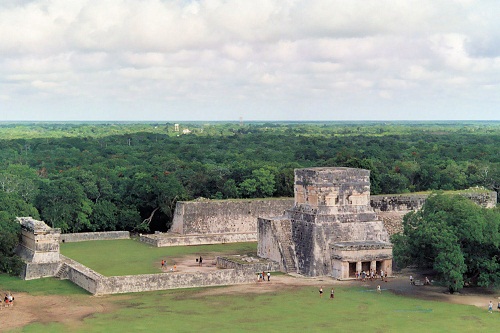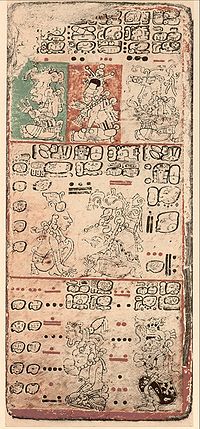
Maya watchtowers discovered to align with solstices and equinoxes
 In 2012, archaeologists announced news concerning astronomically aligned structures at the Mayan site of Chichen Itza in the Yucatan. Previously largely overlooked, these ruined towers surrounding the long ceremonial area or “Great Ball Court” have now been analyzed and determined to possess alignments to the equinoxes and solstices.
In 2012, archaeologists announced news concerning astronomically aligned structures at the Mayan site of Chichen Itza in the Yucatan. Previously largely overlooked, these ruined towers surrounding the long ceremonial area or “Great Ball Court” have now been analyzed and determined to possess alignments to the equinoxes and solstices.
Alignments to the equinoxes have been known at a number of Mesoamerican sites, including and especially “El Castillo” or the Temple of Kukulkan at Chichen Itza. Indeed, important Mexican religious festivals were known to be held on the equinoxes, particularly the vernal or spring, during which time at El Castillo the sun’s shadow projects an undulating “serpent” down the side of the temple’s staircase. It should be recalled that the Mesoamerican god Kukulkan is portrayed as a “feathered serpent,” the meaning of both “Kukulkan” and “Quetzalcoatl,” as he is known by his Nahua/Aztec moniker. He is also significantly a solar god, a fact that should be kept in mind whenever reading the myths and traditions concerning Quetzalcoatl (and his eponymous priest-kings).
The spring resurrection of solar and foliage deities
 One of the most important annual Mesoamerican celebrations occurs at the vernal equinox, the “Festival of the Sun,” to whom human sacrifices were made at this time. One esoteric Mesoamerican motif concerning the vernal equinox, it has been claimed, is the death and resurrection of a nature god, whether by the name of Kukulkan/Quetzalcoatl or the maize god, which are often syncretized, as is logical and common for foliage and solar deities. The same common process of religious syncretism occurs with the Egyptian god Osiris, who is, among other aspects, the sun, water and foliage, this latter represented by his green color symbolizing the chlorophyll of plants.
One of the most important annual Mesoamerican celebrations occurs at the vernal equinox, the “Festival of the Sun,” to whom human sacrifices were made at this time. One esoteric Mesoamerican motif concerning the vernal equinox, it has been claimed, is the death and resurrection of a nature god, whether by the name of Kukulkan/Quetzalcoatl or the maize god, which are often syncretized, as is logical and common for foliage and solar deities. The same common process of religious syncretism occurs with the Egyptian god Osiris, who is, among other aspects, the sun, water and foliage, this latter represented by his green color symbolizing the chlorophyll of plants.
The timing of this Mesoamerican festival with the spring sacrifice, death and resurrection at “Easter” of the New Testament godman Jesus Christ rates as noteworthy and a logical parallel, as this time of the year traditionally represents the rebirth of life after the death of winter. The maize god/Quetzalcoatl mythology revolves around the sprouting (birth) of the foliage, by virtue of the “Hero Twins” (soli-lunar powers) penetrating the “underworld” (soil) and defeating the “lords of death,” allowing the sprout to burst through the surface and bring with it the “new dawn.” As is also sensible, this time of the year is that of the great maize/earth/growth goddess and “Mother of the Gods” in Mesoamerican mythology, also found in other myths, such as the stories of Cybele and Demeter, symbolizing the Creatrix (parthenogenetically) bringing forth life in abundance.
The relevant myth concerns the (solar) primordial god “Heart of Sky,” who in the Popol Vuh is also the (solar) “Feathered Serpent” (Kukulkan/Quetzalcoatl) and the Maize God in the underworld who is avenged by his twin sons and “magically resurrected.”
 The cross and crucifix
The cross and crucifix
It should also be noted that the symbol of the cross was very sacred to the Maya, appearing in a variety of forms and representing the four cardinal points or “corners of the world,” as was said of the four canonical gospels by early Church father Irenaeus. This theme of the cross representing a solar symbol indicating the four directions of north, east, south and west is very ancient and popular in many cultures globally. Indeed, it may well be one of the oldest symbols of the past 10,000 or more years.
In this same regard, Quetzalcoatl is represented as affixed to a cross, much like the crucifix of Jesus, representing his solar nature as holding power over the four directions.
Venus mythology
 It is also well known that the Maya were ardent observers and worshippers of the planet Venus, held to be a god, such as Kukulkan, whose “beard” is a typical feature in Venus mythology. Venus is also said to be the “twin” of the sun. Many Mayan sites such as Uxmal possess Venus alignments, and astronomical/astrological “Venus tables” are present in the Dresden Codex, a pre-Columbian Mayan text evidently created during the 11th or 12th centuries AD/CE but representing knowledge from three or four centuries earlier.
It is also well known that the Maya were ardent observers and worshippers of the planet Venus, held to be a god, such as Kukulkan, whose “beard” is a typical feature in Venus mythology. Venus is also said to be the “twin” of the sun. Many Mayan sites such as Uxmal possess Venus alignments, and astronomical/astrological “Venus tables” are present in the Dresden Codex, a pre-Columbian Mayan text evidently created during the 11th or 12th centuries AD/CE but representing knowledge from three or four centuries earlier.
The winter solstice
It has been determined (once again) that the Maya at Chichen Itza were also interested in the solstices, which are not as prominent in these equatorial regions as they are elsewhere. Nevertheless, it would have been difficult to believe that these supreme astronomers were not aware of and did not observe the solstices, especially since the sun was a major factor in Maya religion. Indeed, both the equinoxes and the solstices were “key dates in the calendar for corn cultivation.”
In cultures farther to the north, the sun at the winter solstice is considered to be dead and then resurrected or reborn, amid great rejoicing, as the days begin to become longer again, bringing with them light, warmth and growth. While the winter effect may not be so dramatic in Mesoamerica, such solar myths may also have been present at some point in Mexican religion and mythology, which do, indeed, speak of multiple suns being born and dying. One of these solar deities, as we have seen, is Kukulkan/Quetzalcoatl, the second sun, who is killed and goes into the underworld, where he is rescued and reborn on Earth. It could be considered a crime against humanity that thousands of Mayan codices were destroyed, depriving us of so much more possible data, but we are glad that the Maya currently are recovering much of their ancient knowledge.
The Caracol at Chichen Itza
In this regard of solstitial alignments, in addition to the watchtowers around the ball court, it has been evinced for decades that the round Caracol at Chichen Itza is likewise an observatory. The map below from Exploratorium.edu shows the various alignments of the Caracol, including the solstices.
Maya watchtowers marked astronomical seasons
Experts say sun’s rays shone through slits during solstices and equinoxes
Experts in Mexico say they have determined that the ancient Maya used watchtower-style structures at the temple complex of Chichen Itza to observe the equinoxes and solstices.
The bases of the structures were found atop the walls of the long ceremonial court, where a ritual ball game was played. But to determine their use, archaeologists first had to rebuild the small, stone-roofed structures.
Each of the structures has a narrow slit running through it.
Government archaeologist Jose Huchim says he has found that the sun’s rays shine into the slits at the winter solstice, and at another angle on the equinoxes.
The sun played an important role in Maya culture, for religious as well as agricultural reasons, the National Institute of Anthropology and History said in a statement on Thursday. For instance, equinoxes and solstices were key dates in the calendar for corn cultivation.
Archaeologists believe the Maya ball game was itself an analogy for the sun’s journey through the sky: “The sun’s course — that is, rising from the east, reaching the zenith and being hidden in the west — is at a given time reproduced through the movement of the ball during the practice of ritual,” Huchim said.
Huchim said that stairways to the structures are being restored so visitors can observe the phenomenon.
Further Reading
Our Lord and Savior Quetzalcoatl
Chichen Itza 3D Site Animation
2012: A New Beginning
Astrotheology of the Ancients
Quetzalcoatl, the Maya Maize God, and Jesus Christ
3 thoughts on “Maya watchtowers discovered to align with solstices and equinoxes”
Comments are closed.



Michener on solar importance to ancient Canaan rel
In James Michener’s 1965 novel, [i]The Source[/i], an archeological dig is conducted at an ancient town site located in present-day Israel. In the chapter relating events from the year 2,280 BCE, the following passage appears:
[quote]In this age of uncertainty, only one thing was certain: the confusion about religion had been permanently settled. It was now known that the world was governed by three benevolent gods—storm, water, sun—and each was represented by a special monolith rising from the high place in the center of town. There was, of course, a fourth stone in the solemn line facing the temple, sacred beyond all others, rounded on top by erosion and almost submerged in earth that had accumulated through the years. Because it looked something like a human penis, it was revered as the father of all gods and was known as El, but in appearance it was trivial, rising only a few feet from the soil, whereas the others were impressive monuments. It was as if the god to whom this rock-penis belonged was old and worn out; he was still revered by his subjects as a potent force, the source of all power, the god El.[/quote]
A few pages later, there is a description of the events which occurred on the last day of the winter season (i. e., the last day of the old year) and on the following day, the beginning of the spring season (i. e., the first day of the new year). The follow paragraph describes a solar astronomical element of the observance:
[quote]On the last day of the dying year the town fasted and, before dawn, assembled at the western end of the temple, where doors not used at any other time were thrown open. At the eastern end similar doors were opened so that the townsmen could look straight through the empty hall, from west to east, and as the sun approached on this day when day and night were of equal length, all grew reverent and whispered prayers imploring Baal-of-the-Sun to protect this town for another year. The sun rose, and the astronomy of the priests was so exact that the rays shone straight through the temple without touching any wall. The year would be a good one.[/quote]
16. Explain in everyday (non-academic) words what a solstice and equinox are.